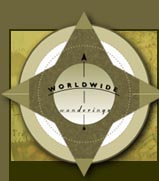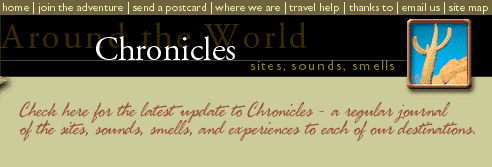|
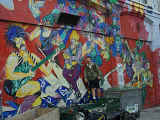 Sept. 5-11, 1998 Amsterdam, Netherlands Sept. 5-11, 1998 Amsterdam, NetherlandsAmsterdam
– I have been so taken with this enchanting city, I’m afraid that I too, have
fallen victim to its spell. I should have seen it coming. The first line, in the first
paragraph, in the Amsterdam section of our Frommer’s guidebook explains: "In
Rotterdam they work, in The Hague they rule, but in Amsterdam they live." Well, in
support of this theory, here I am, our third day in this captivating city, having ignored
my ‘work’ and now FORCING myself to take the time to carve out a quiet moment
and make a few notes. Not that I’m vying for pity.
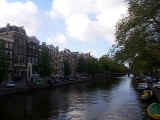 As a ‘slave’ over this keyboard, Laura and I are
comfortably relaxing at our small, candlelit table on the sidewalk outside one of the
hundreds of Amsterdam’s unpretentious little cafés. It is dusk. The city sounds that
surround us, as we gaze over the canal recounting the events of the day, include the
muffled voices of people at the other tables talking and laughing in a myriad of other
languages, the occasional jingle of a chain guard, fender, or lock rattling on one of the
many bicycles that speed by our table on the cobblestone walk, and finally, the classic
marching tunes being trumpeted out by the high school band practicing their timing, notes,
and regimented steps across the canal and up the block. As a ‘slave’ over this keyboard, Laura and I are
comfortably relaxing at our small, candlelit table on the sidewalk outside one of the
hundreds of Amsterdam’s unpretentious little cafés. It is dusk. The city sounds that
surround us, as we gaze over the canal recounting the events of the day, include the
muffled voices of people at the other tables talking and laughing in a myriad of other
languages, the occasional jingle of a chain guard, fender, or lock rattling on one of the
many bicycles that speed by our table on the cobblestone walk, and finally, the classic
marching tunes being trumpeted out by the high school band practicing their timing, notes,
and regimented steps across the canal and up the block.
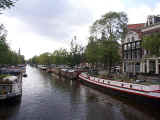 There is so much – too much – to
write about this place. Of all the cities I have visited, both in the States and abroad,
this one is in the lead in competing for my favor. I have, as of yet, been unable to
denote why. One of my early theories was that I simply instantly felt comfortable here.
Although the city of nearly ¾ of a million people has one of Europe’s proudest
heritages (in the 17th century, Amsterdam was the world’s most prosperous
port), the city and its people are neither arrogant nor contemptuous, but just the
opposite. It seems that they are extremely tolerant and non-judgmental of others. As new
guests in the city (often times making small social blunders, fumbling to find correct
change, or pestering someone for directions) we were always met with both a kind word and
smile. There is so much – too much – to
write about this place. Of all the cities I have visited, both in the States and abroad,
this one is in the lead in competing for my favor. I have, as of yet, been unable to
denote why. One of my early theories was that I simply instantly felt comfortable here.
Although the city of nearly ¾ of a million people has one of Europe’s proudest
heritages (in the 17th century, Amsterdam was the world’s most prosperous
port), the city and its people are neither arrogant nor contemptuous, but just the
opposite. It seems that they are extremely tolerant and non-judgmental of others. As new
guests in the city (often times making small social blunders, fumbling to find correct
change, or pestering someone for directions) we were always met with both a kind word and
smile.
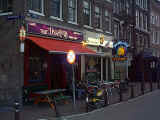 Hand
in hand with this friendliness, is the city’s tolerance (and lenience) for alternate
dress, sexual preference, public behavior, use of ‘recreational stimulus’,
choice of ‘entertainment’, and so on, and so on. The city’s over all feel
and attitude can best be summed up as "live and let live". Hand
in hand with this friendliness, is the city’s tolerance (and lenience) for alternate
dress, sexual preference, public behavior, use of ‘recreational stimulus’,
choice of ‘entertainment’, and so on, and so on. The city’s over all feel
and attitude can best be summed up as "live and let live".
Laura and I arrive mid afternoon on Saturday. We find out from our visit to the
tourist information office (VVV), that this is a great time to experience the sights and
sounds of the city, but a very bad time to find a place to rest your weary head after long
and full day is done. 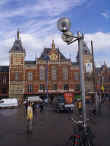 We do find a room
in a large hotel on the outskirts of the city, immediately check in, dump our packs, and
take the train back to Central Station to stroll the streets and take in
the action. We do find a room
in a large hotel on the outskirts of the city, immediately check in, dump our packs, and
take the train back to Central Station to stroll the streets and take in
the action.
It was basic sensory overload. Imagine, the atmosphere of the French Quarter and Times
Square rolled into one. Now change the languages of each of the party-goers to anything
but English, make almost anything that they choose as their vice-o-the-night completely
legal, now throw the scene into a maze of small, narrow streets lined with 17th
century 4-5 story elaborately façaded structures. That’s the party district of
Amsterdam. Don’t know how much, if any, detail of our evening is appropriate here.
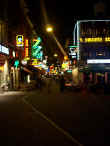 I can mention an Italian restaurant
with about a dozen drunken singing Englishmen; a little hole in the wall dive bar with a
very friendly (and tanked) Dutch truck driver and his father; and a 63 year old (had
worked there for 30 of those years) barmaid that didn’t look a day over 40 who could
probably hop over the bar and toss you out on the street as fast as you could say
"Heineken Dark". I can mention an Italian restaurant
with about a dozen drunken singing Englishmen; a little hole in the wall dive bar with a
very friendly (and tanked) Dutch truck driver and his father; and a 63 year old (had
worked there for 30 of those years) barmaid that didn’t look a day over 40 who could
probably hop over the bar and toss you out on the street as fast as you could say
"Heineken Dark".
The next few days were a blur of one scenic city street after another.
Amsterdam was indeed a ‘big’ city complete with all of the constant buzz of
activity practically around the clock. Each and every street was lined with 300-400 year
old buildings. We walked, we rode the tram, we walked some more. I’m convinced that
we must have covered almost every kilometer of the old city of Amsterdam. A few of the
highlights include, in no particular order:
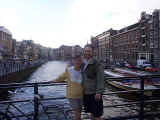 Centraal Station, probably the most stunning example of a public
transportation station in the world. St. Nicholaaskerk (St. Nicholas’ Church
– that’s right, this is Santa’s entry point to the city at the beginning of
each Christmas season. The sex museum (yes, it’s just like a real museum only
with a somewhat interesting, and somewhat, excuse the expression, ‘touchy’
subject matter). The infamous red-light district where anything and everything
goes, and most of it is legal. The name comes from store-front type windows lined with red
tubes of light. Inside, the ‘merchandise’. Working girls of every shape, color,
and size. The Waag (Weigh House) on Niewmarket Square. Constructed in 1488
to serve as a city gate, it has since served as fire station, weigh house, and a teaching
hospital. It is here that Rembrandt observed classes before painting The Anatomy
Lesson. Centraal Station, probably the most stunning example of a public
transportation station in the world. St. Nicholaaskerk (St. Nicholas’ Church
– that’s right, this is Santa’s entry point to the city at the beginning of
each Christmas season. The sex museum (yes, it’s just like a real museum only
with a somewhat interesting, and somewhat, excuse the expression, ‘touchy’
subject matter). The infamous red-light district where anything and everything
goes, and most of it is legal. The name comes from store-front type windows lined with red
tubes of light. Inside, the ‘merchandise’. Working girls of every shape, color,
and size. The Waag (Weigh House) on Niewmarket Square. Constructed in 1488
to serve as a city gate, it has since served as fire station, weigh house, and a teaching
hospital. It is here that Rembrandt observed classes before painting The Anatomy
Lesson.
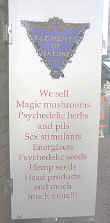 In between our informal sightseeing
excursions, we twice dropped into an Internet Café to check our mail (unfortunately, of
the 12 or so adapters I bought, none worked in the Netherlands, so we 'had' to check out
this cafe). This place, as well as the other coffee shops, gave a new meaning to the
phrase ‘second-hand smoke’, whew!! In between our informal sightseeing
excursions, we twice dropped into an Internet Café to check our mail (unfortunately, of
the 12 or so adapters I bought, none worked in the Netherlands, so we 'had' to check out
this cafe). This place, as well as the other coffee shops, gave a new meaning to the
phrase ‘second-hand smoke’, whew!!
Back to our exploring, we also took in the Schreierstoren,
sometimes called the Weeping Tower, or Tower of Tears. It is from this tower that Henry
Hudson left to discover that famous river named after him. You guessed it – The
Hudson river (and of course New Amsterdam, today known as New York City).
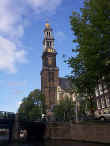 Our canal bike ride
gave us a great shot at Westerkerk (West Church), Amsterdam’s tallest, and in
my opinion, most handsome tower. This was also the source of serenades by some 47 bells in
its tower. Our hotel, Hotel Groote, was nearby, so we had the pleasure of being
able to set our watches to these merry tunes each half hour, every half hour. We found
ourselves many times in Dam Square strolling past the Koninklijk Paleis
(Royal Palace). This huge hall has an interesting history. Built as a town hall in 1655,
it was converted into a private residence (the whole thing) by none other than Louis
Bonaparte, yes, Napoleon’s brother. He lived here as King of Holland, until word of
unrest made him decide to ‘get outta’ town’ in 1810. Our canal bike ride
gave us a great shot at Westerkerk (West Church), Amsterdam’s tallest, and in
my opinion, most handsome tower. This was also the source of serenades by some 47 bells in
its tower. Our hotel, Hotel Groote, was nearby, so we had the pleasure of being
able to set our watches to these merry tunes each half hour, every half hour. We found
ourselves many times in Dam Square strolling past the Koninklijk Paleis
(Royal Palace). This huge hall has an interesting history. Built as a town hall in 1655,
it was converted into a private residence (the whole thing) by none other than Louis
Bonaparte, yes, Napoleon’s brother. He lived here as King of Holland, until word of
unrest made him decide to ‘get outta’ town’ in 1810.
The Munttoren (Mint Tower), overlooking the floating flower
garden, also chimes out tunes every half hour. In 1672, the building was used to mint
money (the Dutch were at war at the time, and had their money supply cut-off) and the name
stuck ever since.
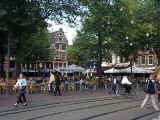 Rembrandtsplein
and Leidseplein were two of Amsterdam’s most popular and hippest hangouts.
Bars, restaurants, and of course coffee shops offer refreshment inside, or out. Choosing a
table outside will often include a show by jugglers, mimes, or musicians. One particular
night, Laura and I were milling around and were drawn in by a fellow playing an instrument
he designed himself called a Dulcimer. We had a brief chance to chat with Lindsay
Buckland (see an interview in "In Their Words" soon) about his travels,
before a sudden Amsterdam downpour sent us our separate ways. Rembrandtsplein
and Leidseplein were two of Amsterdam’s most popular and hippest hangouts.
Bars, restaurants, and of course coffee shops offer refreshment inside, or out. Choosing a
table outside will often include a show by jugglers, mimes, or musicians. One particular
night, Laura and I were milling around and were drawn in by a fellow playing an instrument
he designed himself called a Dulcimer. We had a brief chance to chat with Lindsay
Buckland (see an interview in "In Their Words" soon) about his travels,
before a sudden Amsterdam downpour sent us our separate ways.
|
